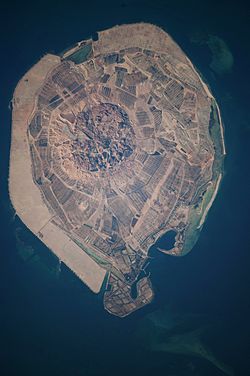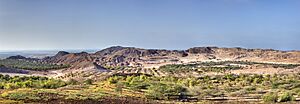Sir Bani Yas facts for kids
|
Native name:
صِـيـر بَـنِى يَـاس
|
|
|---|---|

This astronaut photograph illustrates the varying character of surfaces on Sir Bani Yas
|
|
| Geography | |
| Location | Persian Gulf |
| Coordinates | 24°20′N 52°36′E / 24.333°N 52.600°E |
| Area | 87 km2 (34 sq mi) |
| Length | 17.5 km (10.87 mi) |
| Width | 9 km (5.6 mi) |
| Administration | |
| Emirate | Abu Dhabi |
| Demographics | |
| Ethnic groups | Arabs |
Sir Bani Yas (Arabic: صِـيـر بَـنِى يَـاس) is a beautiful natural island in the United Arab Emirates. It is located about 170 kilometers (105 miles) southwest of Abu Dhabi, which is the capital city. The island is also about 9 kilometers (5.6 miles) offshore from Jebel Dhanna.
Sir Bani Yas is the largest natural island in the UAE. It stretches 17.5 kilometers (10.9 miles) from north to south and 9 kilometers (5.6 miles) from east to west. This special island was once home to the biggest wildlife reserve in Arabia.
The reserve covers over 87 square kilometers (33.6 square miles). It was started in 1977 by Sheikh Sheikh Zayed. Thanks to many years of hard work, the island now has thousands of wild animals roaming freely. Millions of trees and plants also grow there. Sir Bani Yas is a safe place for birds and other wildlife. You can enjoy adventure safaris, kayaking, mountain biking, archery, hiking, and snorkeling.
Contents
Island History
The name Sir Bani Yas comes from the Bani Yas tribe. This tribe was among the first people to live in Abu Dhabi. The island itself was formed millions of years ago. It is the top of a giant salt dome created by natural forces deep underground.
Early Settlers and Ancient Sites
People first came to Sir Bani Yas thousands of years ago. So far, 36 ancient sites have been found across the island. Each site tells us something new about the island's past.
One of the oldest discoveries is a Christian monastery. This monastery dates back to about 600 AD. It is now carefully protected to keep it safe. This church is the only pre-Islamic Christian site found in the UAE. It was opened for visitors in December 2010.
Archaeologists led by Dr. Joseph Elders found the church in 1992. Dr. Elders believes that Nestorian Christians used the church until around 750 AD.
European Discoveries
Europeans first wrote about Sir Bani Yas around 1590. A jeweler from Venice named Gasparo Balbi mentioned "Sirbeniast." He said that pearls were often found around this island. British naval officers also described the island in detail in the 1820s and 1850s. They were mapping the waters of the lower Persian Gulf.
Sheikh Zayed's Vision
In 1971, Sheikh Zayed became the first president of the United Arab Emirates. He chose Sir Bani Yas as a peaceful place to visit. In 1977, he made a rule to stop hunting on the island. He then started to turn it into a wildlife reserve. This was part of his "Greening of the Desert" plan.
The plan aimed to make desert areas better for people to live in. It also created a safe home for many endangered animals from Arabia. Millions of trees were planted, and many animal species were brought to the island. These included gazelles, oryx, llamas, rheas, giraffes, and ostriches.
Once the reserve was ready, Sheikh Zayed wanted to share it with everyone. So, it was opened for weekend tourists. These visits became so popular that people often had to book more than a year in advance!
Desert Islands Project
In 2007, the government of Abu Dhabi created the Desert Islands project. This project brought together Sir Bani Yas, nearby Dalma Island, and six smaller sandy islands. Sir Bani Yas and Dalma Islands are now developed and open to visitors. The six other islands are currently closed to the public.
Wildlife and Nature
Sir Bani Yas is a haven for many different animals. You can find Arabian oryx, Somali ostriches, gazelles, and deer. There are also reticulated giraffes, dolphins, and sea turtles. More than 100 types of wild birds live on the island. Many of these birds are native to the region.
The island has about 30 kinds of mammals. This includes different types of antelope. It also has one of the world's largest groups of endangered Arabian oryx. The Arabian oryx is a type of antelope that was once extinct in the wild. But now, over 400 of them roam freely on Sir Bani Yas.
Arabian Wildlife Park
The Arabian Wildlife Park covers about half of Sir Bani Yas. It gives wild animals a safe place to live freely. The island is still open for people to visit. The park is home to about 13,000 animals that are native to the Arabian Peninsula. These include the endangered Arabian Oryx, Sand Gazelle, and Mountain Gazelle. You can also see wild predators and scavengers like the cheetah and striped hyena.
The park focuses on research and protecting animals. But it also offers many fun activities for visitors. You can go on game drives to see animals, explore nature trails, or go mountain biking. You can also enjoy outdoor dining.
Protecting Endangered Species
Sir Bani Yas helps protect many animals that are in danger. The International Union for the Conservation of Nature (IUCN) lists these animals as critically endangered or vulnerable. These include sea turtles, sand gazelles, Barbary sheep, Arabian tahr, and oryx. The island plays a very important role in making sure these animals survive for the future.
More than 10,000 animals from Sir Bani Yas have been moved to other wildlife reserves. One such reserve is in the Liwa Desert on the Abu Dhabi mainland. This program is done with the Environment Agency Abu Dhabi.
Island Hospitality
On the northwest side of the island, next to a lagoon, is the Desert Islands Resort & Spa by Anantara. This resort has 64 rooms, including six private lodges. It also has three restaurants, a spa, a health club, a kids' club, and business facilities.
Some cruise lines, like MSC Cruises, use a small part of the island. It serves as a Private island stop for their week-long cruises. This area has beaches and places to get drinks and food.
Sustainability Efforts
The island is being developed carefully. This is to protect its nature and delicate ecosystem. Sir Bani Yas has the first wind turbine in the region. It can produce 850 kilowatts of energy. This energy helps power the island's facilities. It works alongside the regular electricity supply from the national grid.
The island also uses solar energy. This power helps some of the staff housing that is not connected to the main electricity grid. Masdar, a company from Abu Dhabi that focuses on renewable energy, plans to increase wind power production to 30 megawatts.
Getting There
You can fly to the island through Sir Bani Yas Airport.
See also
 In Spanish: Sir Bani Yas para niños
In Spanish: Sir Bani Yas para niños



